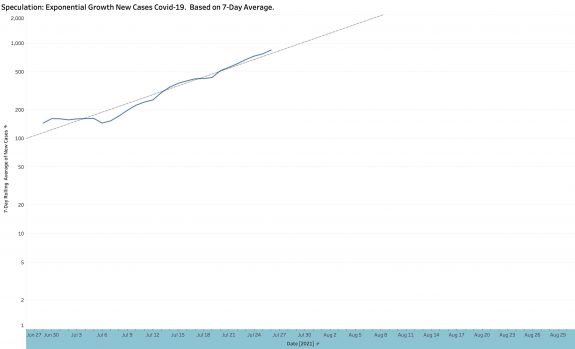Unless one has been living in a cave these past months (or the modern equivalent of being totally off the grid) it is impossible not to acknowledge that the world, our nation, and our state of Kentucky are entering a sustained major surge in Covid-19 disease that has already shown its ability to duplicate some of the worst experiences to date for the pandemic. Since July 1, 2021, every reported indicator used to monitor new cases in Kentucky has been moving together in exactly the wrong direction. These include daily and weekly new cases and their 7- and 14-day averages, Kentucky’s calculated Test Positivity Rate (TPR), and rising hospital and ICU utilization. That the rate expansion of Kentucky’s epidemic is increasing daily is indicated by a 7-day new-case rate that exceeds the 14-day rate; and that since July 1, new cases have been rising exponentially with an estimated doubling rate of about every 10 days. These indicators put us in the same place we were in last summer before the nightmare of last winter’s holiday surges. Because the state has decreased its reporting days, the following graphics summarize the date only up to Friday, July 23. [See addendum at end of the article for update through 26 July 2021.]
Overview of Aggregate New Cases and Deaths:
This has been KHPI’s summary graphic for over a year. With over 7-million viral tests counted, at least 474,444 unique cases of Covid-19 were diagnosed. Virtually all authorities assume this is a gross undercount. One might assume that counting deaths would be more accurate, but even the 7312 Kentucky deaths counted so far are surely an undercount of the actual mortality that can be said to have been caused by the Coronavirus. Large one-day increases in deaths reported in March and June attest to the fact that we did not have reliable timely systems in place to track Covid-19 deaths, let alone the excess deaths due to disruption of the healthcare system. Similar artifacts in reports of cases and tests occurred that complicated our epidemic surveillance and predictions. This epidemic caused more misery than illness and deaths alone. Social disruption was massive– and continues.
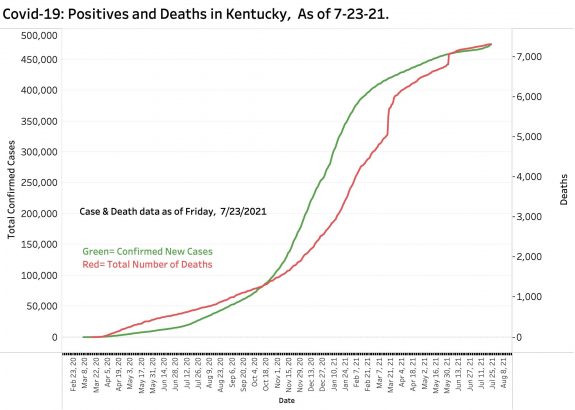
7-day Average Daily New Case and Death Counts.
Because reporting systems follow a calendar of days of the week and holidays, day-to-day variation in counts swings widely. Kentucky and much of the rest of the nation no longer issues reports over the weekends. It is now customary to use 7- or even 14-day averages to identify trends, albeit delayed and after the fact. Assuming little change in reporting systems one does not need sophisticated statistical analysis to discern a relentless increase in new cases since July 1. No such increase has been observed as yet in Kentucky as has been seen in other states, but as demonstrated by the figures below, hospitalizations and deaths reliably follow rising cases by weeks not days. (Note the artifactual spikes in deaths in March and June.)
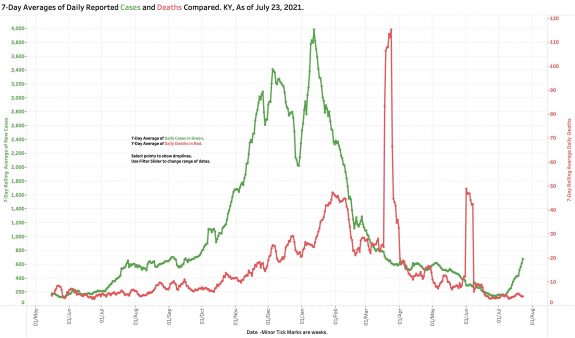
Weekly Case Counts.
Another way to even out or average case, death, or test counts is to summarize counts by week or months. The figure below shows weekly (Sunday to Saturday) counts of new cases since March of 2020. The most recent week displayed of 4224 additional new cases as defined by KHPI but does not include cases from Saturday, July 24. Conservatively adding another estimated 900 cases would give a total of 5124 for the week. This is be the highest since February’s fall from our winter surge and puts us in the same place as September 2020.
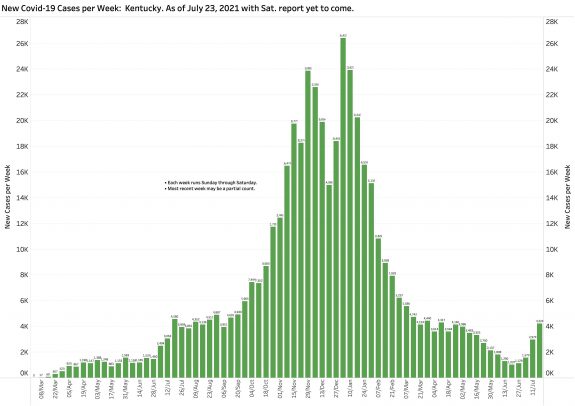
Test Positivity Rate.
Kentucky uses a calculated positivity rate that is based on a 7-day average of certain electronically reported tests that are positive. This is different than raw daily positivity rates which are higher, but has the important advantage of being more reliable. The nearly vertical climb of the brown TPR curve is frankly scary. The 7-day average of new cases is dutifully following along behind.
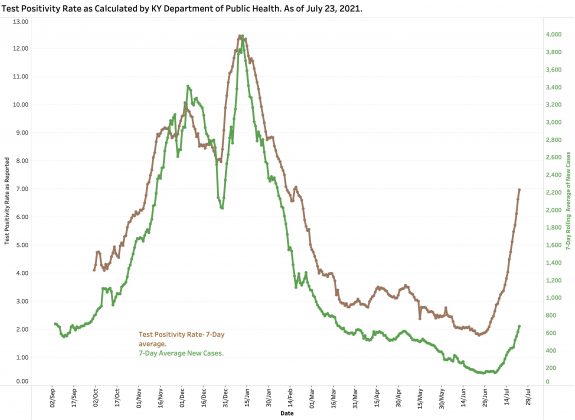
Hospital Utilization.
Test Positivity Rate tracks along not only with new cases, but also with hospitalizations. The following graphic displays the relationship of TPR with reported “Currently In Hospital” counts since December of 2020 when the new method of calculating TPR was introduced. Everything was going in a desirable directing until this July. The relentless deviation upwards is not a direction in which we want to be going. (A similar plot of TPR against 7-day new cases looks very much the same.)
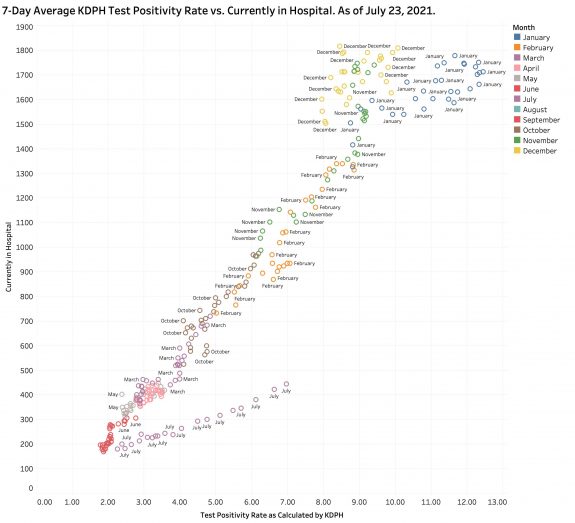
Below is KHPI’s usual graphic display of hospital and ICU census statewide. Censuses for both categories are unmistakably going up. Anecdotal reports from physician friends suggest things are worse. Note too that the majority of hospital beds are located in counties with larger populations. The new case rates in smaller counties of Kentucky with lower vaccination rates is now where the disease action putting more pressure on smaller hospitals or in counties where there is no hospital all! A few US states have currently reached full capacity. We do not want to be there.
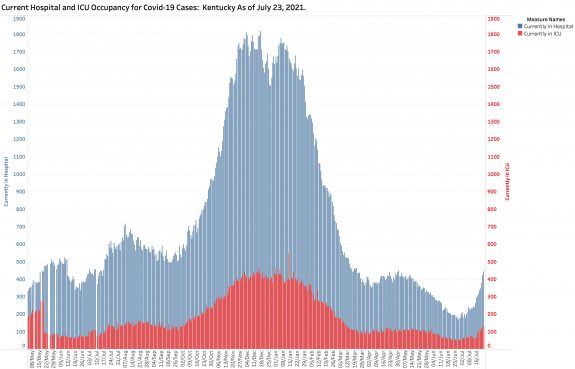
We are experiencing exponential expansion of the epidemic!
These last slides depict the 7-day rolling average of new cases over time using a semi-log plot. Note that the left-hand axis in not linear, but logarithmic. This gives an advantage of allowing both small and large numbers to be displayed on the same graph. In addition, as has been explained before these pages, if the plotted points conform to a straight line in a semi-log plot against time, that the curve is rising exponentially. Ideally, raw unaveraged daily case counts should be plotted but day-to-day counts vary greatly including days with no reports at all. My best analysis of 7- and 14- day averages, raw case counts, and weekly counts suggest a doubling of every 10 days or so. Since July 1, The Test Positivity Rate has been doubling about every 10-12 days. These are not good signs in my view! If nothing else changes, we could be back in the thousands of case per day by the end of August.
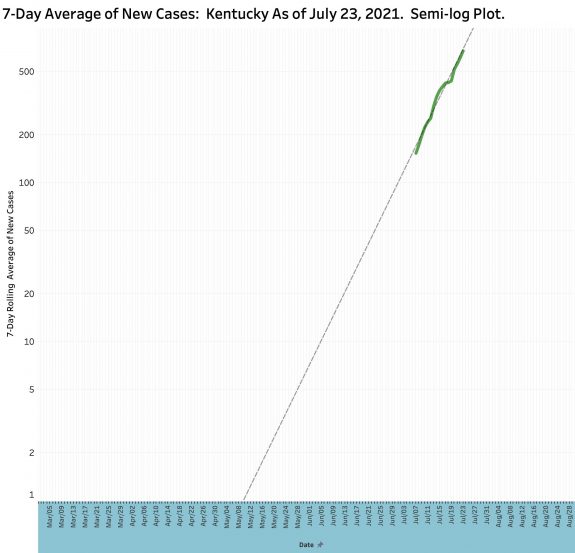
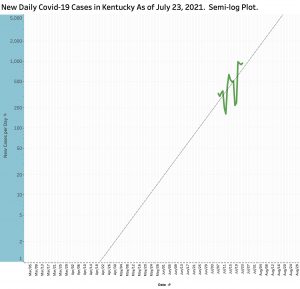
What is driving these surges?
A new strain of Coronavirus, names Delta has rapidly become the predominant strain in Americas and globally. It is thought to be at least twice as infective as earlier strains and seems to cause more significant disease. The vast majority of individuals getting sick with Covid-19 today are unvaccinated. Existing vaccines obviously still work but continued vigilant studies will be ongoing including the need for booster shots. Younger people continue to make up the most rapidly expanding age group with symptomatic or worse infections.
Certainly, there are non-viral reasons why we are entering a new epidemic wave. Public health measures have been relaxed. Hot weather puts people back indoors. Large-scale public events are coing back. Epidemic fatigue and a desire for the good old days drives the behavior of many. Surely the major factor involved is the fact that large segments of the population in Kentucky remain unvaccinated for whatever reason, including personal or political choice. For them, the epidemic is starting all over again where they live, work, play, or go to school. They will take their contagion with them wherever they go and keep the epidemic cooking.
Can we do anything about the firestorm that is coming?
Recommendations about renewed emphasis on mask wearing have been made by Kentucky’s public health officials. Mandates about mask wearing have not been made because it is assumed that even this mild government requirement would not be effective because mandates will not be followed! I suspect armed insurrection is also a legitimate concern.
Our public health officials nationally and in Kentucky make the rational and defendable point that with the availability of vaccination against Covid-19 available in America, that we could stop the epidemic largely in its tracks. (People in less developed countries wish they had this option at all!) A reasonable person might ask the question that if vaccination is so effective and acceptably safe, why is it not being mandated just as immunizations for school are mandated? I recently read that a few bats were found around Jefferson County that had rabies. I learned that all dog and cat owners in the county were mandated to have their pets immunized against rabies in order to protect the health and safety of our human residents. What will it take to apply a parallel decision for us humans to “promote the general Welfare” against epidemic diseases? That is a discussion that exceeds the space in this article. My fear, and frankly my prediction is that Covid-19 will again have its way with us and things will get a lot worse– real fast. One can only hope that as a community we come to our senses sooner rather than later and recognize the reciprocal obligations we have to each other, individually and through our government.
Peter Hasselbacher, MD
Emeritus Professor of Medicine, UofL
President, KHPI
July 23, 2021
The full current portfolio of KHPI’s data visualizations is available on Tableau Public. These interactive graphics enable the user to select ranges of dates or otherwise focus on selective data.
Addendum 27 July 2021:
As of yesterday evening’s state Covid updates for the previous three weekend and Monday days, it is clear that Kentucky’s explosive, indeed exponential surge of its epidemic continues unabated. This is true of new cases, hospital and ICU utilization, and Test Positivity Rate. The total daily number of new tests and deaths remain stable. At the current rate of epidemic expansion, unless public behaviors or something else changes, we will hit a 7-day average of 1000 new cases per day by August 1 and 2000 cases by August 10th or so. (Raw new-case counts will reach these levels days before the 7-day average.)
Peter Hasselbacher, MD
